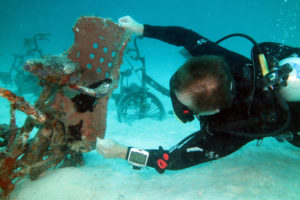PADI CEO and President Dr. Drew Richardson heads up the world’s largest scuba-diving training agency, and he is determined to mobilize this huge network of divers as a force for good. Recently at the Maldives Underwater Festival he shared his vision for an army of ocean ambassadors working for marine conservation.

In 2017, PADI announced a corporate philosophy that embraces ‘four pillars of change.’ Is this something you are personally spearheading?
Yes, the idea of paying if forward and making a meaningful difference drives my desire to guide PADI forward as a global force for good. As we’ve grown, our purpose has expanded to include a stronger responsibility and commitment to take care of the environment. As the largest certifying agency in the world, PADI and its network of divers, teaching professionals and dive shops can mobilize as a force to impact the health of the underwater world. This commitment to ocean health has become an integral part of the PADI corporate ethos. To be the best in the world, we all must be the best for the world by protecting the ocean planet we love.
What brought about the shift to focusing on awareness of ocean-conservation issues?
PADI’s long-standing commitment to ocean conservation began over 25 years ago with formation of the Project AWARE Foundation, which I was personally involved in. I currently serve as the chairman of the board for the foundation. In 2017, we introduced the PADI Pillars of Change to drive awareness of issues affecting our ocean communities, and to mobilize PADI professionals and divers to act together as a catalyst for change. PADI’s environmental commitment starts at home and expands to divers and members in 183 countries and territories around the globe.
Over the coming years, we will amplify our Pillars of Change force for good ethos around the world. Our mission to ‘be best in and for the world’ will be top of mind, with consumers and the PADI name synonymous with ocean conservation. By enabling everyone to become a citizen scientist, we are part of the solution for a clean, healthy ocean.
Was there a personal catalyst that shifted your focus to marine conservation?
It started early in my life and has continued throughout my academic and diving career in the aquatic space. At the 50th anniversary of the PADI organization I thought deeply about my role as President and CEO of the world’s largest diving organization and what our mission should be for the next for the next 50 years. We have a large international database of active and concerned divers who have an emotional connection to the ocean. The population of the planet has swollen, and the pressure and problems are now amplified. If divers don’t speak for the seas then who will?
The Underwater Festival highlighted two marine conservation issues for me:
* The importance of marine parks
The fish stocks on our first dive, in a no-take zone, were incredible. What is PADI doing (or what can PADI do) to educate people about the importance of marine sanctuaries?
* Responsible management of marine life encounters
While it’s wonderful that the Maldives protects its whale-shark population, it was disappointing to see such high numbers of snorkelers in the water with them. How can PADI help educate/influence government departments to better manage this?
Education is key. Robust and measurable diver-centric citizen-science programs, developed in concert with Project AWARE are in play. We’re contributing in part by managing the largest underwater citizen-science database on the planet. This enables divers to report data that, in turn, can be aggregated and shared at the policy level.
Continued partnerships with NGOs like Mission Blue also amplify our message and leverage PADI’s communication and strength as a leader in ocean-conservation both within and outside of diving. We are working to create a sustainable dive industry by pioneering a global environmental assessment program for dive stores and resorts. We are also evaluating a carbon-offset program for divers and industry stakeholders to reduce their environmental impact.
I encourage people to start with the “man in the mirror.” Stay informed and do what you can to make the world a better place and become a more powerful catalyst for change. Start conversations. All of us who care about these issues can amplify engagement efforts to support life below the waters of this world and support initiatives which promote the sustainable use of oceans, seas and marine resources. We encourage divers to align with like-minded businesses and organizations.
The diving community will become powerful change agents who share a likeminded love, mission and passion to be a force for good, to tackle and mitigate the problems which threaten our ocean planet.
And finally, a personal question…can you remember the moment that converted you into a scuba diver for life?
Yes, my first breath off of a double-hose regulator — in a dingy old pool, in the basement of a gray and faceless apartment building in Chicago, Illinois in 1971 did it. It was so sweet, so liberating. The entire immersion was life transforming —breathing air underwater. I was hooked instantly and still am.

